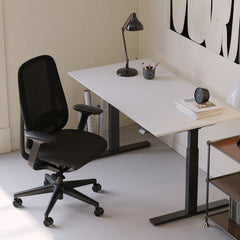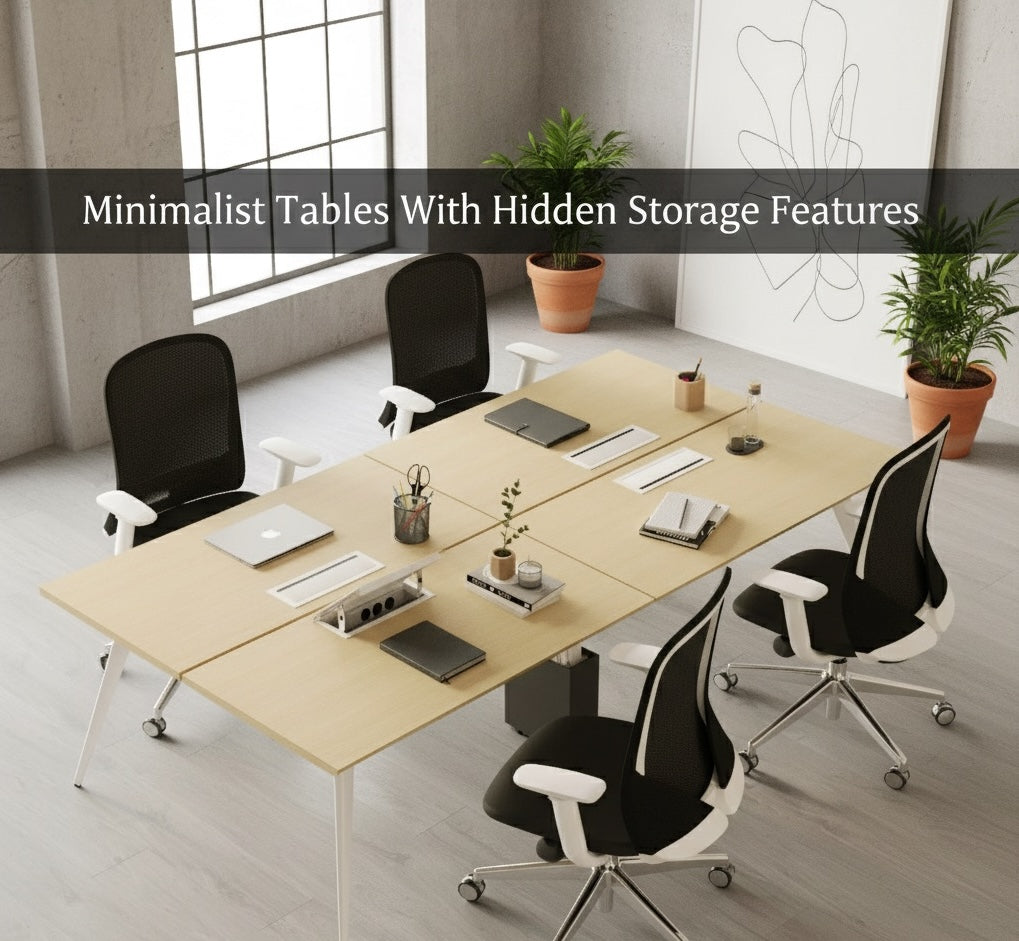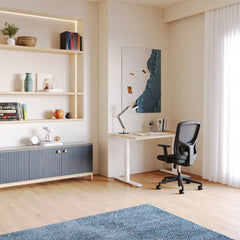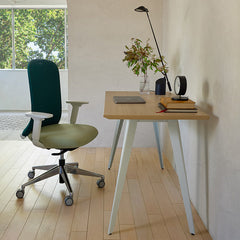Get 10% off your first order
Find the office furniture that’s designed to match your style, comfort, and needs perfectly. Subscribe
Blending Comfort, Quality, and Modern Style

Visit quiz page to see how we makes it easy to create an inspiring workplace


Minimalist interiors prioritize clarity, proportion, and restraint. The challenge is that real life brings mail, remotes, chargers, notebooks, and cables. A minimalist table with hidden storage reconciles these realities by preserving clean planes and slender silhouettes while offering concealed capacity where it matters. This combination supports a calmer room, quicker tidying, and smoother daily routines.
Hidden storage preserves uninterrupted surfaces, so light travels farther and materials read as continuous. When small items have a precise place under the surface, the tabletop stays free for work, dining, or display. The result is a room that feels larger, less busy, and easier to maintain.
A successful minimalist table respects negative space beneath and around it. Designers use slimmer aprons, inset bases, or tapered legs to lighten the profile. Storage volumes are sized to sit inside this geometry so the piece still breathes in the room.
Push-to-open slides, under-mounted tracks, concealed hinges, soft-close dampers, and recessed pulls keep lines clean. The best hardware choices reduce the number of visible components and ensure quiet operation that does not disrupt focus.
Joinery choices like dowels, biscuits, dovetails, and hidden fasteners carry the load without introducing external brackets. Edges stay crisp, surfaces stay flush, and storage compartments do not telegraph through the top.
Slim pencil drawers that sit behind a seamless front.
Lift-top panels that reveal shallow trays for chargers and stationery.
Drop-down doors on the apron to access cable cavities.
Underslung trays mounted to the frame for power strips and hubs.
Magnetic panels that release to reveal micro compartments for remotes or dongles.
| Storage mechanism | Best use case | Visual impact | Access speed | Capacity | Notes |
|---|---|---|---|---|---|
| Slim drawer with push latch | Everyday tools and stationery | Hidden face, clean edge | Fast | Low to medium | Works on most table types |
| Lift-top with counterbalance | Laptop storage, quick stow | Surface breaks only when open | Medium | Medium | Check hinge quality to avoid racking |
| Apron drop-down door | Cable channel access | Invisible seams when closed | Medium | Medium | Good for media or work tables |
| Underslung tray | Power strips and hubs | Invisible from seated view | Fast | Medium | Keep trays set back from knees |
| Magnetic micro panel | Remotes, cards, keys | No visible pulls | Fast | Low | Ideal for living rooms and entry tables |
Surface height, leg clearance, monitor placement, and the relationship between chair and tabletop determine comfort through a full day. Designs that enable varied postures help reduce strain on the neck, shoulders, and lumbar region, which supports focus.
Thoughtful workstation setup improves comfort and productivity. Reference the evidence-based ergonomics guidance from NIOSH for principles on neutral reach, visual angles, and movement frequency that complement minimalist furniture decisions.
Minimalist rooms rely on uninterrupted planes and carefully edited lines. Exposed cables create tangles and visual chatter that distract from the composition and the materials. The solution is to treat cable routing as an integral design layer, not an afterthought.
Power entry should be close to where devices are used, and routing should follow the table’s geometry. A low-profile clamp-on power module brings outlets within reach while keeping the top clear. Pair that with an under-desk tray that hides power strips to capture bricks and surge protectors, and a vertical cable spine for tidy floor-to-desk runs to lead cords to the floor in an orderly column.
Compact studios and secondary bedrooms often serve multiple functions. A table that conceals accessories and chargers avoids the storage overflow that small rooms struggle to hide. The right piece keeps circulation paths open and prepares the surface for whatever comes next, from work tasks to shared meals.
Where square footage is limited, one table may need to support both seated and standing work. A compact height-adjustable workstation for small rooms fits narrow wall spans or alcoves and provides clearance for knees and storage without adding bulk.
Changing posture through the day can support comfort. A sit-stand desk that supports healthy movement enables regular position changes without introducing visual clutter, especially when paired with concealed power and cable organization.
Clients and colleagues notice clarity and order first. A professional desk with integrated cable routing presents a tidy front edge, a clean underside, and a surface that remains open for laptops and notebooks, which communicates focus and intention.
Light woods, soft textures, and daylight-friendly finishes pair well with flush fronts and shallow drawers. Use rounded corners and matte finishes to reduce glare and visual weight. Storage pulls back from the edge so the table reads as a single plane.
Space between objects matters as much as the objects themselves. Hidden storage supports the principle of leaving surfaces free so that the table becomes a quiet place to work or gather. Texture and grain stay visible without interruption.
Concrete, steel, and dark timbers can feel heavy if cables and accessories are visible. Concealed storage lightens the composition and lets the raw materials speak clearly. A compact cable spine and underslung tray maintain the purposefully exposed structure without clutter.
Natural oak or ash for warmth and visible grain.
Walnut for depth without busy patterning.
Matte lacquer for consistent light diffusion.
Brushed metal for subtle reflectivity that does not overpower.
Durable finishes resist micro-scratches and fingerprints so the surface looks composed even with daily activity. Edge treatments remain modest to avoid calling attention to themselves. Hardwearing topcoats, careful sanding, and sealed underside edges keep the feel consistent.
Frames use engineered panels or solid rails to prevent sagging. As storage is added, cross rails or concealed metal sections keep the table rigid. Drawer bottoms and lift panels should resist bowing so seams stay even and operation remains smooth.
Sustainability pairs naturally with minimalism. Responsible wood selection, recyclable metals, and replaceable hardware extend product life. A curated desk collection for modern interiors offers configurations that prioritize longevity, neutral styling, and parts that can be maintained over time.
Measure wall spans, window clearances, and door swing arcs.
Map chair pull-back zones and walking lanes around the table.
Model cable entry points on the wall or floor so routing remains invisible.
Note storage needs by category so compartments are correctly sized.
Leave breathing room on both sides of the table. Keep legs inside the edge to maintain visual lightness. When adding trays or drawers, confirm knee clearance and chair arm swing. The goal is a piece that never collides with daily movement.
Remote controls, game controllers, and charging cables benefit from shallow drawers and lift panels. A magnetic micro compartment keeps small items from sliding around. Cable passthroughs in the apron guide leads to an underside tray.
If the dining table also serves as a studio, choose shallow lift sections for pencils and chargers so the full surface stays usable. Keep storage volumes near the ends so seating along the long side remains comfortable.
Modular trays and accessible cable channels matter most. Position a clamp-on power point where it will not conflict with elbows. Check that trays are deep enough for bricks but set back from knees.
Assign a function to each compartment and label discreetly.
Use shallow dividers for everyday items so they do not layer and disappear.
Coil cables to a consistent diameter and secure with soft ties.
Keep one empty slot for temporary items so clutter never lands on the surface.
Once a month, remove items that migrated into hidden spaces without a purpose. A short reset keeps drawers light and mechanisms stress-free. Revisit labels if categories change so you maintain a one-touch put-away habit.
Lift-tops should open smoothly and stay in position. Drawers should not extend so far that the table becomes front heavy. Finishes should be low glare to reduce eye strain. Child-safe closures are appropriate where curious hands are around.
Clearances should accommodate mobility aids and different seating types. Handle-free designs can include tactile cues at the underside for easier grip. Consider soft radii at corners to improve comfort and safety in narrow rooms.
Best for remote work and study zones where devices and cords are always present. Underside trays, apron channels, and slim drawers keep tools close and visuals calm.
Shallow drawers store remotes and notebooks, while lift sections handle occasional laptop use. The top should remain visually unbroken when closed.
Ideal for entryways where keys, sunglasses, and mail accumulate. Hidden trays keep the landing zone calm and make the first impression of the home more orderly.
1. Identify the primary function of the table for the majority of days.
2. List the essential items that need regular storage within arm’s reach.
3. Choose a storage format that matches those items by volume and access frequency.
4. Confirm knee, leg, and chair clearances with the chosen mechanism.
5. Plan power entry and exit points to keep cables invisible.
6. Match finish and hardware to the room’s light and texture palette.
7. Verify that the table remains stable when drawers or lift panels are open.
A compact table with a single center drawer holds pens and chargers. An under-desk tray carries the power strip. A cable spine drops to the floor behind a leg so no cords cross the wall. The surface stays open for a laptop and a small task light.
A slender coffee table with two micro drawers and a concealed apron channel routes cables to a low cabinet. When guests arrive, controllers slide into the drawers and the room reads as a simple arrangement of planes and textures.
A height-adjustable desk with a shallow lift section stows sketch tools. A clamp-on outlet placed at the rear corner powers devices without reaching under the table. The setup converts quickly from guest sleeping area to quiet creative space.
Large drawers add weight and reduce legroom. Choose the smallest storage that serves the specific items you need to put away.
Visible power bricks, dangling adapters, and loose strips undermine the design. Route and contain them using trays and spines that match the table’s geometry.
When compartments hold unrelated items, clutter returns. Keep a simple rule that each space has one purpose and clear it routinely.
Use nonabrasive cloths and neutral cleaners suited to the finish. Address spills promptly to preserve tone and texture. Tighten concealed fasteners during seasonal changes so mechanisms remain aligned.
Slides benefit from occasional cleaning and alignment checks. Lift hinges should be inspected for equal tension across the panel so the surface closes flush.
In tight layouts where focus matters, a compact height-adjustable workstation for small rooms keeps equipment organized and movement comfortable while preserving negative space.
For rooms that demand frequent posture change, a sit-stand desk that supports healthy movement pairs well with concealed trays and a cable spine so the profile stays clean.
Client-facing offices benefit from a professional desk with integrated cable routing. The table reads as a single volume because routing and power are managed out of view.
Collection-based planning for cohesive rooms
If you are building an office from scratch, a curated desk collection for modern interiors helps align finishes, leg forms, and storage strategies so the entire space feels resolved.
| Dimension to confirm | Recommended target | Why it matters |
|---|---|---|
| Knee clearance height | About 60–65 cm, depending on chair | Prevents contact with trays or drawers |
| Leg clearance depth | About 45–55 cm from front edge | Avoids knocking into apron or storage |
| Chair push-back lane | About 90 cm behind seating | Preserves circulation and comfort |
| Cable drop zone | Directly behind a leg or central span | Hides the path from view |
| Power access zone | Rear corner or center back edge | Keeps outlets reachable and discreet |
Locate outlets at rear corners or under the back edge so cords do not cross the surface. A clamp-on module can be color matched to the table so it recedes visually, and a tray underneath captures adapters so the top remains calm.
Store chargers in a lift compartment when not in use. Coil cables to consistent lengths so drawers close cleanly. Keep one visible charge point for daily phone use and route the rest out of sight.
When the surface only holds the tools for the task at hand, attention stays on the work. Concealed compartments keep alternate tasks and distractions out of the field of view, which supports deeper focus.
Hidden storage enables a quick sweep that prepares the room for the next use. A clear tabletop welcomes the next activity without visual residue from the last one.
Future iterations will continue to refine mechanisms so they stay silent and easy to operate. Materials will favor durability, repairability, and neutral finishes that age gracefully. Power and data will remain accessible without introducing visual noise, and compartments will be designed for the specific tools people actually use.

Blending Comfort, Quality, and Modern Style

Unclutter Your Life: The Simple Genius of Modern Furniture

Engineered Elegance: Where Modern Furniture Design Gets Smart
Get 10% off your first order
Find the office furniture that’s designed to match your style, comfort, and needs perfectly. Subscribe
Leave a comment